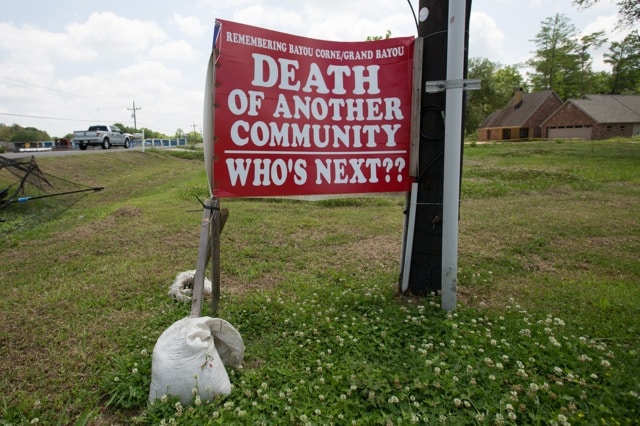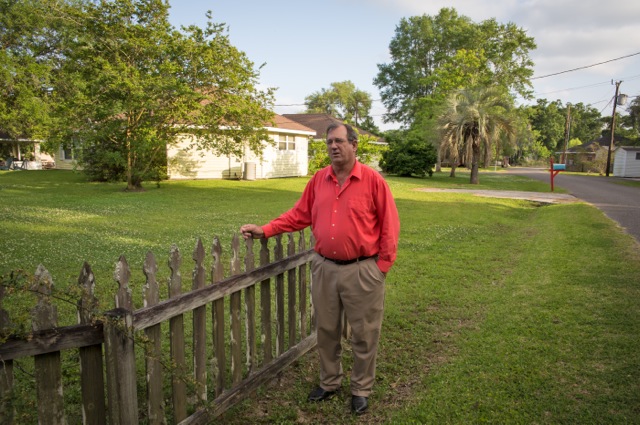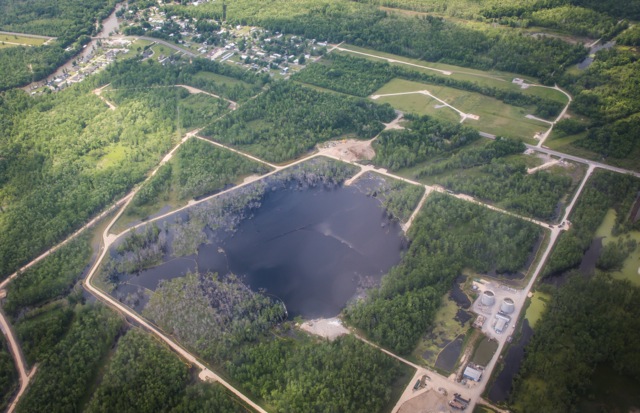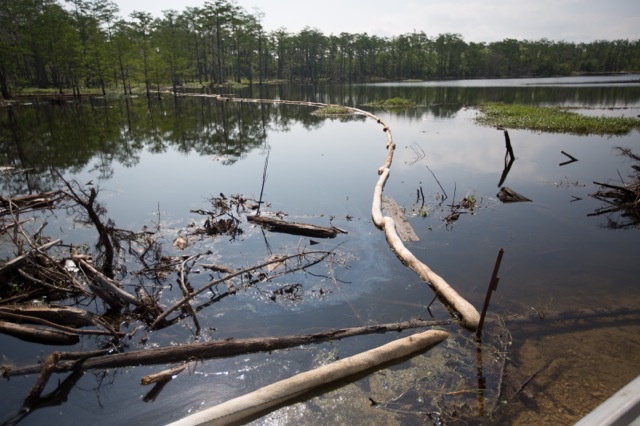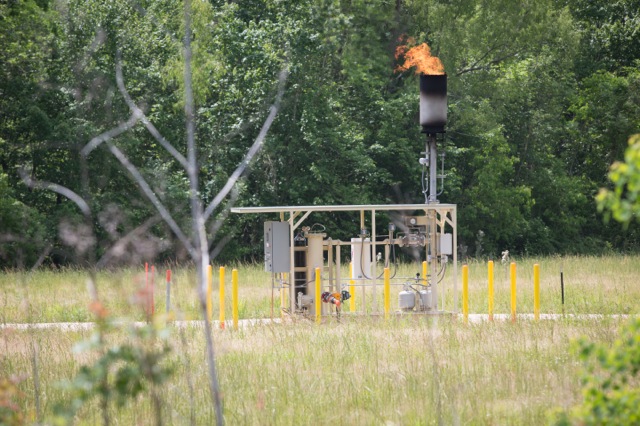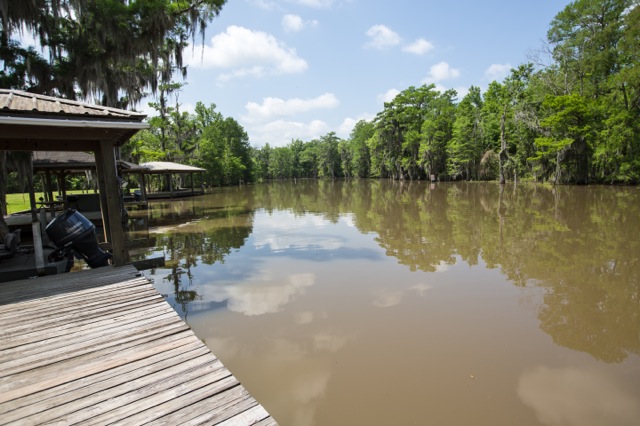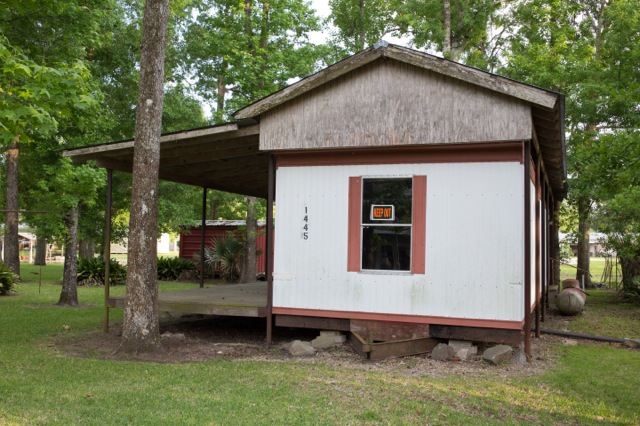It’s been almost two years since a salt mine collapsed in Bayou Corne, 77 miles from New Orleans, causing a sinkhole to open up and natural gas to spread under nearby homes.
Since Aug. 3, 2013, a swath of Assumption Parish has remained under a state of mandatory evacuation.
The area, known as a sportsman’s paradise for its waterways rich in fish and alligators, has become a danger zone threatened by rising gas pressure. Only a few of its 350 residents remain after the collapse of the salt mine owned by Occidental Chemical Corp. and operated by Texas Brine Co. LLC.
“The situation in Bayou Corne remains dangerous,” John Boudreaux, the director of emergency preparedness for Assumption Parish, told DeSmogBlog.
It is his job to keep those who still live there safe.
“125 feet below us — where the aquifer is — there is a layer of gas that has to be removed. Until they can get it removed, the risk continues,” he said.
Boudreaux’s August 2013 video of the sinkhole sucking up moss-covered cypress trees brought international attention to the story.
Assumption Parish emergency preparedness director John Boudreaux in Bayou Corne. ©2014 Julie Dermansky
The state of Louisiana is holding petrochemical company Texas Brine Co. LLC responsible.
“Scientists believe the Texas Brine cavern was mined too closely to the outer face of the Napoleonville Dome, a massive salt deposit, and had a catastrophic wall collapse or breach that led to the sinkhole,” the Baton Rouge Advocate reported.
Though Texas Brine still denies culpability, it is legally obliged to maintain the site and prevent the sinkhole from contaminating the surrounding cypress swamp.
“Our program to locate and mitigate shallow gas in the aquifer has made great progress,” the company’s website says. It also says the sinkhole is stabilizing.
Patrick Courreges, a spokesman for the Department of Natural Resources, agrees there are signs of stabilization, but since this is an event without precedent, it is impossible to know when the sinkhole will stop growing or when the gas will make its way out of the aquifer.
“As long as the gas is in the aquifer at levels we are seeing, we still see a threat,” Courreges told DeSmogBlog.
The sinkhole has grown from three acres to more than 29 acres.
Recently, Gary Hecox, a senior hydrogeologist with engineering firm CB&I and a leading scientist on the state’s sinkhole response, told residents at a meeting, there is more gas in the aquifer than originally thought.
Texas Brine has been ordered to install new pressure monitor wells to obtain more data.
Boudreaux told DeSmogBlog one of his biggest challenges is keeping Texas Brine in emergency mode, noting the company recently announced it is in maintenance mode.
“The sinkhole caused gas to be released into the aquifer and spread underneath the town,” Boudreuax explains. “The gas has the potential to fill a home undetected and explode. That hasn’t changed.”
Bayou Corne resident Mike Schaff never evacuated, but he doesn’t doubt that the situation is dangerous. He says he couldn’t see himself living in a hotel for a long period of time or staying with family. Since the incident began, Schaff has learned how vulnerable he and his community are when it comes to dealing with industry.
Frustrated by the lack of leadership, members of the community called former General Russel Honoré for help. Honoré has since become a spokesman for those negatively impacted by industry in Louisiana and established a ‘Green Army‘ made up of a coalition of environmental groups, and concerned citizens, including Schaff. The Green Army is introducing new legislation and fighting to block bills it believes hurt the state.
Bayou Corne resident Mike Schaff next to his home. ©2014 Julie Dermansky
On April 24, Schaff testified before the Senate on a new bill that would require any company that causes a sinkhole to provide residents with replacement value of impacted homes within 180 days. The bill passed in committee and will now be voted on by the Senate. This new bill won’t help Schaff, but he doesn’t want others to have to go through what he has.
April 24th, 2014: Bayou Corne Sinkhole. ©2014 Julie Dermansky
Schaff recently circled over the sinkhole in his Cessna. Texas Brine’s outer levee appears closer to the sinkhole than Schaff had imagined.
“It is just a matter of time before it breaches through there and impacts the bayou,” Wilma Subra, a Louisiana-based environmental scientist, told DeSmogBlog.
Absorbent boom catching sheen on the surface of the sinkhole.©2014 Julie Dermansky
A few weeks ago, Boudreaux got the Department of Environmental Quality to have Texas Brine clean the surface of the sinkhole because oil was accumulating on the surface and emitting hydrocarbons. Boudreaux says the company put out absorbent boom and oil absorbent paper towels for the first time since the disaster began.
The Department of Natural Resources maintains that air pollution in the area is not significant, but Subra disagrees.
“Breathing in hydrocarbons over a period of time is cumulatively bad for your health, even if it’s at a low level. Those who remain in Bayou Corne continue to breathe the emissions of the crude that is coming to the surface,” Subra says.
A $48.1 million settlement was reached between Texas Brine and the class action lawyers, but it is unclear how many residents will accept it. Some have suggested that after the legal expenses are deducted, the remaining sum divided among more than 90 plaintiffs won’t amount to much.
Texas Brine is also facing lawsuits from pipeline companies, large landowners and the state and parish governments.
The company could also be facing fines for not providing the Department of Natural Resources with information that may have changed the outcomes of permits issued prior to the sinkhole, according to Courreges.
Vent well burning off gas spread by the sinkhole. ©2014 Julie Dermansky
“It is up to Mother Nature to decide how long it will take for this disaster to go away,” Schaff says.
Courreges and Boudreaux have come to the same conclusion.
Schaff scoffs when he hears anyone talk about Bayou Corne being a paradise lost.
“No, this paradise was stolen by Texas Brine,” he says.
Deck behind a home in Bayou Corne. ©2014 Julie Dermansky
One of many evacuated homes in Bayou Corne. ©2014 Julie Dermansky
Subscribe to our newsletter
Stay up to date with DeSmog news and alerts


